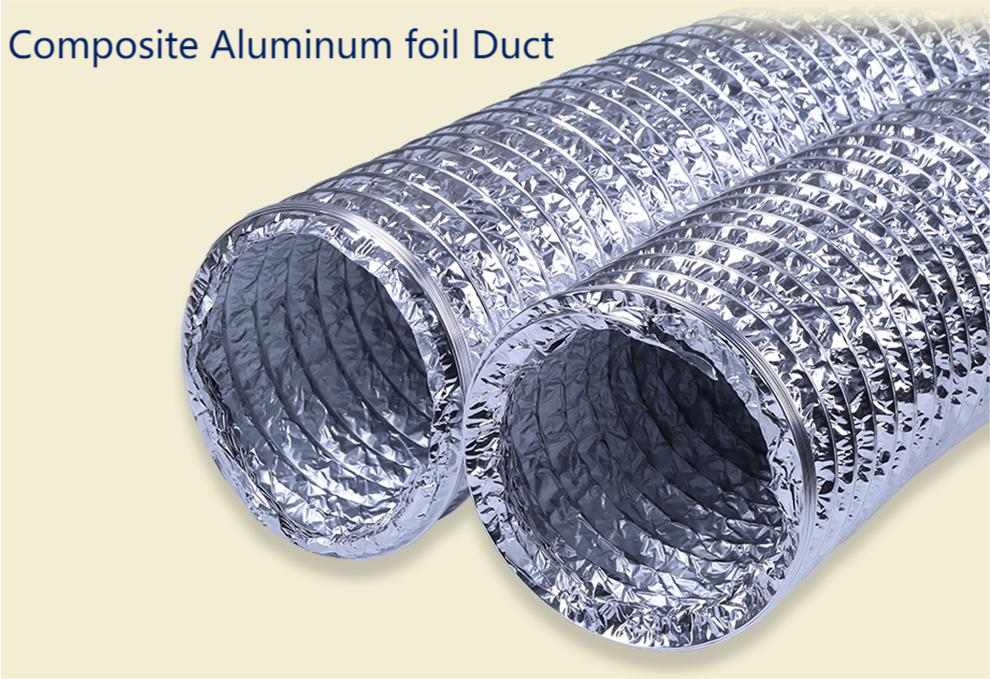Selecting the right ductwork material is crucial in modern construction and industrial applications. The material of the duct directly impacts its performance, longevity, and maintenance costs. Pure aluminum ducts and composite aluminum foil ducts are two common types available in the market. This article will provide a detailed comparison of these two duct types, highlighting their characteristics, advantages, and suitable applications to help you make an informed decision.
Material Composition
Pure Aluminum Ducts: Pure aluminum ducts are made from high-purity aluminum, often using aluminum alloys to enhance their strength and durability. These ducts have excellent corrosion resistance and can withstand high temperatures and pressures.

Composite Aluminum Foil Ducts: Composite aluminum foil ducts are made by layering aluminum foil with other materials, such as plastic or paper. The aluminum foil layer offers good shielding and reflective properties, while the composite materials enhance the duct’s mechanical strength and durability.
Weight and Installation
Pure Aluminum Ducts: Pure aluminum ducts are relatively lightweight and easy to install. However, due to the soft nature of the material, careful handling is required during installation to prevent deformation or damage.
Composite Aluminum Foil Ducts: Composite aluminum foil ducts are even lighter and easier to install. Their structure makes them more resistant to pressure and abrasion during installation, making them suitable for complex construction environments.
Corrosion Resistance
Pure Aluminum Ducts: Pure aluminum ducts have excellent corrosion resistance, making them ideal for humid or corrosive environments. However, they may oxidize over time, necessitating regular maintenance.
Composite Aluminum Foil Ducts: Composite aluminum foil ducts also offer good corrosion resistance. While their composite structure provides some protection against environmental factors, their overall corrosion resistance might not be as high as that of pure aluminum ducts.
Thermal Conductivity
Pure Aluminum Ducts: Pure aluminum ducts have exceptional thermal conductivity, making them suitable for applications requiring efficient heat transfer. However, this also means that additional insulation might be needed in some cases to prevent heat loss.
Composite Aluminum Foil Ducts: Composite aluminum foil ducts have lower thermal conductivity, making them suitable for applications needing thermal insulation. The composite material layers provide good insulation, reducing heat transfer and loss.

Application Scenarios
Pure Aluminum Ducts: These ducts are suitable for high-temperature, high-pressure, and highly corrosive industrial environments, such as chemical plants and smelting facilities. They are also ideal for commercial buildings and public facilities requiring high-performance duct systems.
Composite Aluminum Foil Ducts: These ducts are better suited for residential and office environments, as well as applications requiring lightweight and flexible ducting. Their ease of installation and cost-effectiveness make them a popular choice for general building and renovation projects.
Cost and Economic Efficiency
Pure Aluminum Ducts: Pure aluminum ducts tend to be more expensive, especially for large-scale applications. While the initial investment is higher, their durability and lower maintenance needs can offer long-term economic benefits.
Composite Aluminum Foil Ducts: Composite aluminum foil ducts are more cost-effective, making them suitable for budget-conscious projects. Their lightweight and easy installation reduce construction costs, making them ideal for large-scale rapid installations.
Conclusion
Pure aluminum ducts and composite aluminum foil ducts each have their own advantages and disadvantages. Pure aluminum ducts are suitable for demanding industrial and commercial applications, offering superior corrosion resistance and thermal conductivity. On the other hand, composite aluminum foil ducts are favored in residential and general building projects due to their lightweight, ease of installation, and good insulation properties.
When choosing ductwork, it is essential to consider the specific application scenarios, budget, and performance requirements to select the most suitable duct type for ensuring efficient operation and long-term use of the system.


